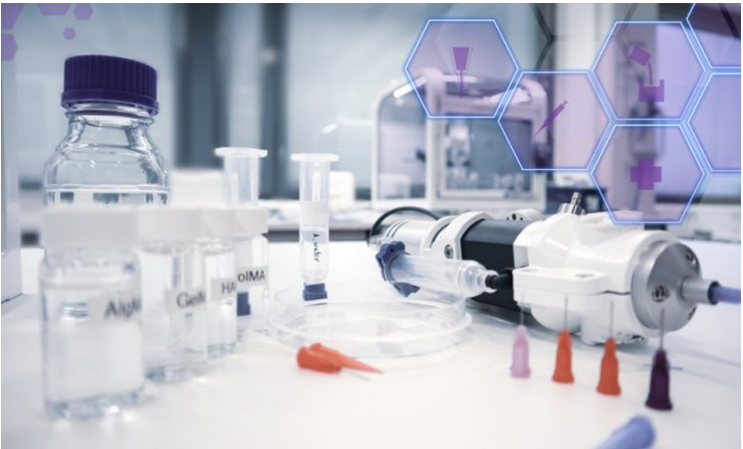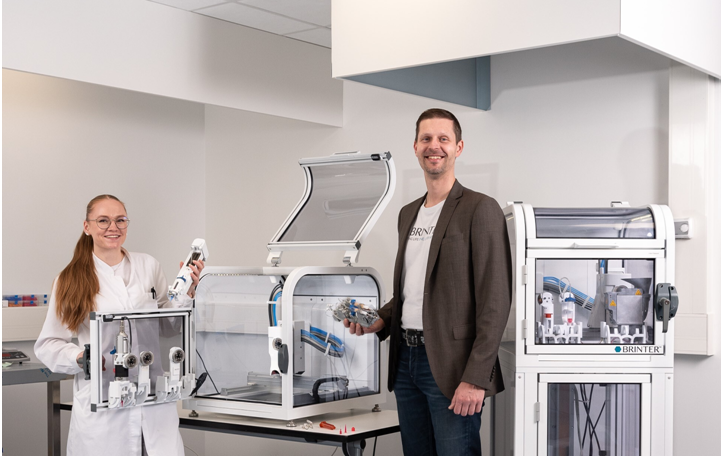By Brinter Ltd.
Brinter slashes cost of high-quality 3D bioprinting with launch of multipurpose “Brinter Core”
Turku, Finland: – Pioneering modular multi-material bioprinting platform developer and manufacturer, Brinter, announced the launch of its new entry-level model, Brinter Core.
The multi-material 3D bioprinting solution is designed to be more portable and is half the cost of its Brinter 1 stablemate, allowing more pharmaceutical companies, hospitals, universities, and research centers to access the technology for applications ranging from personalized drugs to human spare parts.
Modular and portable bioprinter
Brinter Core is a modular and portable bioprinter that is able to print multi-material and highly complex tissue structures in 3D, providing all the basic features needed for bioprinting. The device can print both stiff and soft materials, including liquids and hydrogels with living cells, bio-paste, metal with a binder material, and plastic.
It is also highly portable, capable of being packed away, moved, and set up in a different lab or cleanroom within a few minutes.
Expanding the bioprinter market
Brinter CEO Tomi Kalpio commented: “The market is growing strongly as accelerated technological, material, and methodological developments expand the potential applications for 3D bioprinting. However, many institutions have so far been unable to acquire 3D printing technology at previous price points. Furthermore, many of the researchers and companies who need to deliver products for 3D bioprinting don’t have 3D printers with unlimited bioinks and other materials, again due to their significant costs and also difficulty moving them between labs.”
“Now we are offering Brinter Core as a reasonably priced, yet very capable and less space-consuming alternative that can speed up scientific development by factors of up to ten,” said Mr. Kalpio.
“We really want to open up the 3D bioprinting market in a way that’s never been done before. With the Brinter Core, we make 3D bioprinting a reality for those who were previously boxed out of the market,” he declared.
Expandable solution
Brinter Core performs many of the same functions as its stablemate, using the same printing heads, meaning upgrades are available if required. Dispensing heads are easily swapped between Brinter products without any tools. It can be expanded with compatible Brinter printing technologies that include valve-free pneumatic extrusion (Pneuma Tool), screw-driven mechanical extrusion, i.e. endless piston pump (Visco Tool), solenoid-driven dispensing (MicroDroplet Tool), and thermoplastic granulate extrusion (Granu Tool).
Brinter customers include biotech and pharmaceutical companies like Nanoform, as well as research organizations like VTT, BEST group at the University of Glasgow, Johannes Gutenberg University of Mainz, the University of Oulu, University of Turku, Åbo Akademi, Tampere University, and the University of Helsinki.
Printed human parts
Benefits of 3D bioprinting range from cancer research to printing human “spare parts”, such as kidneys, hearts, or even brains. Brinter aims to help save more lives through more personalized treatment. For example, researchers can print 3D cancerous cells and track how they communicate with each other, allowing researchers to identify the best individual drugs to treat the disease.
“Medical research facilities and universities often still rely on traditional methods of discovery in the research of new drugs, understanding diseases, and finding medical ways to help people. Drug developers are excited to get their hands on the device to do fast prototyping and testing and deliver treatments that save more lives,” says Emeritus Professor Dr. Pirkko Härkönen, Counsellor at Turku University’s Institute of Biomedicine.
About Brinter
Founded in 2020 via partial demerger in Turku, Finland, Brinter is the manufacturer of a modular multi-material bioprinting platform scalable from manual R&D to automated production. The company works with science and bioengineering organizations to integrate 3D bioprinting into their research, manufacturing, and treatment methods. The goal is to break through current technological limitations and improve people’s quality of life.
Brinter has bootstrapped its growth since 2019, when it launched its first product, and is currently active in more than ten countries, including Germany and the UK.
Customers of the company now include bio and pharmaceutical companies like Nanoform, as well as research organizations like VTT, BEST group at the University of Glasgow, Johannes Gutenberg University of Mainz, the University of Oulu, and the University of Helsinki, whose directors are enthusiastic about the technology’s potential.
To date, Brinter has raised a total of €1.2M in funding and is currently active in more than ten countries, including the USA, Germany, India, and the UK.
For more information, visit www.brinter.com.
Resources
Click on Brinter Bioprinters for further products.
Click on Brinter Media Kit for high-resolution images.



















